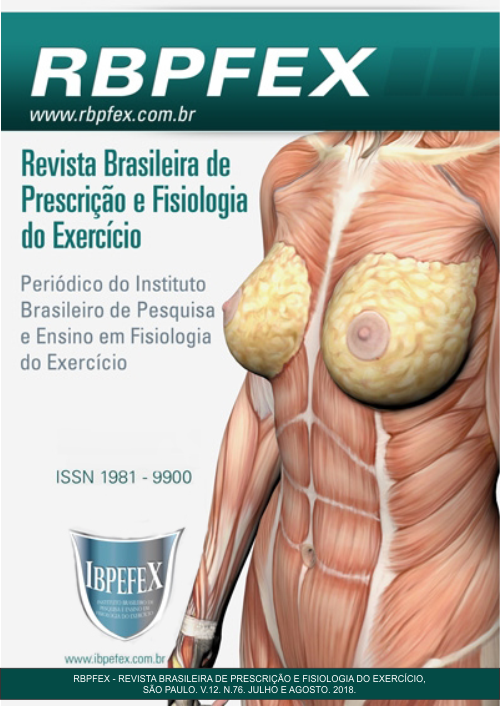Evaluation and comparison of the flexibility of the lombar and hipper region between practicers of traditional active stretching and the stiff deadlift exercise
Abstract
We know that flexibility is an important component of basic physical fitness related to health and quality of life. Almost invariably we use the different types of stretching (active, passive, ballistic) to achieve the improvement of this physical capacity. Another form of exercise that brings the adjective to promote flexibility is resistance exercise, which thanks to the eccentric phase of the movement allows the stretching of the cells of the agonist muscles. Therefore, the objective of this study was to analyze and compare the effects of 8 weeks of traditional active stretching and the stiff deadlift exercise on hip and lumbar flexion (HLF). For this, 16 individuals of both genres were divided into two groups: G1 = Active Stretching (AS: women, n=5 and men, n=3) and G2 = Stiff Deadlift (SD: women, n=5 and men, n=3). All participants were submitted to pre- and post-application protocols, which consisted of 4 sets of 30 seconds (either performing AS or performing SD exercise). In both protocols, 60 seconds intervals were used between the series, being performed twice a week for 8 weeks. As a main result, we observed that after 8 weeks of training, both protocols resulted in a significant improvement (p <0.05) in flexibility. However, there was no statistically significant difference between the experimental groups (AS x SD). Therefore, it is concluded that 8 weeks of SD exercise generated improvement in HLF in the same proportion as the specific exercise (AS) used for this purpose.
References
-Abdallah, A. J. Flexibilidade e alongamento: saúde e bem-estar. Manole. 2009. p. 326.
-American College of Sports Medicine. Recursos do ACSM para o personal trainer. 3ªedição. Rio de Janeiro. Guanabara Koogan. 2011. p.496.
-Astrand, P. O.; Rodalh, K. Tratado de fisiologia do exercício. Rio de Janeiro. Guanabara Koogan. 1987. p. 234.
-Borg, G. Borg's perceived exertion and painscales. Champaign, IL: Human Kinetics. 1998. p. 80.
-Chiesa, L. C. Musculação: aplicações práticas: técnicas de uso das formas e métodos de treinamento. Shape. 2002. p. 145.
-Fatouros, I. G.; Kambas, A.; Katrabasas, I.; Leontsini, D.; Chatzinikolaou, A.; Jamurtas, A.Z.; Douroudos, I.; Aggelousis, N.; Taxildaris, K. Resistance training and detraining effects on flexibility performance in the elderly are intensity-dependent. Journal of Strength and Conditioning Research. Vol. 20. Núm. 3. 2006. p. 634-642.
-Fatouros, I. G.; Taxildaris, K.; Tokmakidis, S.P.; Kalapotharakos. V.; Aggelousis, N.; Athanasopoulos. S.; Zeeris, I. The effects of strength training, cardiovascular training and their combination on flexibility of inactive older adults. International Journal of Sports Medicine. Vol. 23. 2002. p. 112-119.
-Gianolla, F. Musculação: conceitos básicos. Manole. 2003. p. 329.
-Guedes, D.P.; Guedes, J.E.R.P. Proposição de equações para predição da quantidade de gordura corporal em adultos jovens. Semina. Vol. 12. Núm. 2.1991. p. 61-70.
-Harvey, D.; Craig, M. Measuring flexibility for performance and injury prevention. In: Australian Sports Comission. Physiological test for elite athletes. Champaign: Human Kinetics. 2000. p. 134.
-Heyward, V. H. Design for fitness. Minneapolis: Burgess. 1991.
-Kataura, S.; Suzuki, S.; Matsuo, S.; Hatano, G.; Iwata, M.; Yokoi, K.; Tsuchida, W.; Banno, Y.; Asai, Y. Acute effects of the different intensity of static stretching on flexibility and isometric muscle force. Journal of Strength and Conditioning Research. 2006. Ahead of Print.
-Marega, M.; Carvalho, J.A.M.; Manual de atividades físicas para prevenção de doenças. Rio de Janeiro: Elsevier. 2012. p. 266.
-Mookerjee, S.; McMahon, M.J. Electromyographic analysis of muscle activation during sit-and-reach flexibility tests. Journal of Strength and Conditioning Research. Vol.28. Núm.12. 2014. p. 3496-3501.
-Santos, E.; Rhea, M.R.; Simão, R.; Dias, I.; Salles, B. F.; Novaes, J.; Leite, T.; Blair, J. C.; Bunker, D. J. Influence of moderately intense strength training on flexibility in sedentary young women. Journal of Strength and Conditioning Research. Vol. 24. Núm. 11. 2011. p. 3144-3149.
-Thrash, K.; Kelly, B. Flexibility and strength training. Journal Apply Sport Science Research. Vol. 1. 1987. p. 74-75.
Authors who publish in this journal agree to the following terms:
- Authors retain the copyright and grant the journal the right of first publication, with work simultaneously licensed under the Creative Commons Attribution License BY-NC which allows the sharing of the work with acknowledgment of the authorship of the work and initial publication in this journal.
- Authors are authorized to enter into additional contracts separately for non-exclusive distribution of the version of the work published in this journal (eg, publishing in institutional repository or book chapter), with acknowledgment of authorship and initial publication in this journal.
- Authors are allowed and encouraged to post and distribute their work online (eg, in institutional repositories or on their personal page) at any point before or during the editorial process, as this can bring about productive change as well as increase impact and impact. citation of published work (See The Effect of Free Access).






